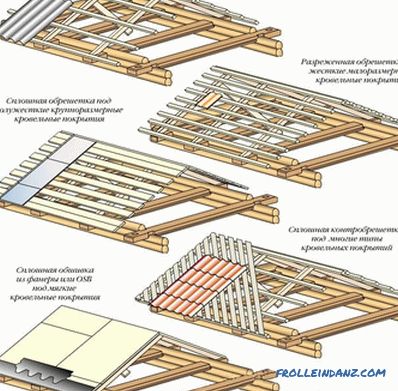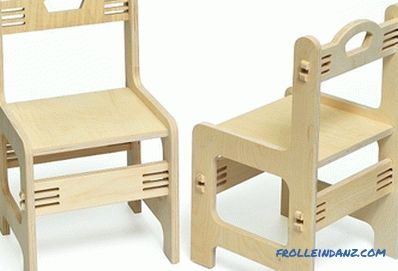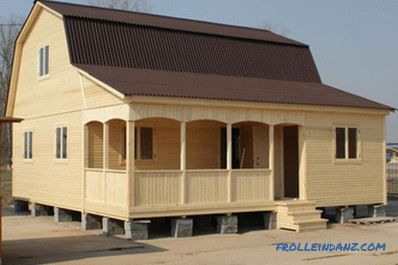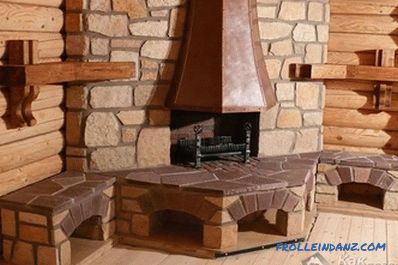Before you choose a construction vacuum cleaner, you need to figure out what tasks it is intended to solve. Only by knowing the capabilities of this equipment and its main characteristics, you can find the best option for you.
A characteristic feature of all construction sites, large industrial premises and small workshops, any places where they work with a perforator, electric jigsaw or wall chaser, is an increased amount of dust, sawdust and other debris. The disadvantage for workers is perhaps the lesser of the evils generated by industrial waste. Fine dust, getting into the lungs of those who are in the workshop or on the repaired object, can cause significant harm to their health. In addition, it often becomes the cause of the failure of power tools. The only correct solution to protect the health of people and the efficiency of electrical equipment, in this situation will be the acquisition of industrial (construction) vacuum cleaner. It will help create comfortable working conditions, ensure safety in the workplace, and reduce the time spent on cleaning the production premises.
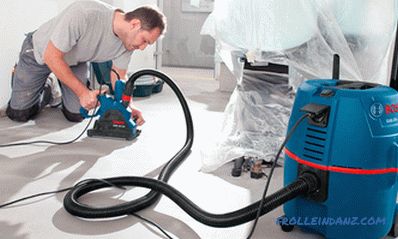
Device, principle of operation and methods of filtering construction vacuum cleaners
Since this article is intended primarily for those who have never been a happy owner of such equipment, start follows ab ovo.
Every newcomer starts by asking the question: "What is a construction vacuum cleaner and why can't I use a regular household vacuum cleaner instead?" Indeed, at first glance, these two electrical appliances are no different than the dimensions. However, having a similar device and principle of operation, they are still designed to solve different problems, and this leaves its imprints in the form of a number of structural features.
So, the main difference between these two varieties of the same device is an object with which to "fight". A household vacuum cleaner does a good job with ordinary light household dust, but if small pebbles are on its way, they are most likely not in the dust collector. The situation will be even worse if someone tries to remove small fraction building dust with a household vacuum cleaner: a significant part of it will “spit out” itself along with the air flow. Moreover, a lot of undigested dust will get into the electric motor, and this will most likely cause the latter to fail.
The industrial counterpart was originally intended for the collection of construction dust and other construction and industrial waste. And the amount of work in question, only by him.
The distinctive features of construction vacuum cleaners include a shock-resistant casing, an increased hose diameter, a large volume of the dust collector (and, as a result of this, considerable dimensions and weight of the unit itself), a highly efficient multi-stage filtration system, high engine power and its ability to work without a break for a long time.
Device and principle of operation
The principle of operation of a vacuum cleaner (in this case does not matter, industrial or domestic) is quite simple and well known to all of us from the school physics course. The fan, driven by an electric motor, creates a strong vacuum inside the vacuum cleaner, which is the main driving force. Air along with dust and other solid inclusions rushes through the hose into this zone of reduced pressure. Most of the debris inside the vacuum cleaner remains inside the dust collector, the remaining mist of the fine fraction of particles is trapped by additional filters. After passing through a multistage filtering system, the purified air is discharged through the outlet to the atmosphere.
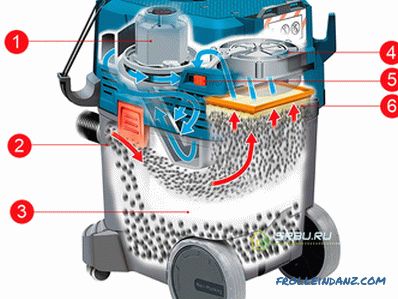
Construction vacuum cleaner device using the example of BOSCH GAS 35 L SFC: 1. Electric motor with a fan; 2. Incoming air flow with garbage; 3. Waste collection container; 4. Filter cleaning system; 5. Switch filter cleaning system; 6. Filter for air purification.
A distinctive feature of construction vacuum cleaners is that dust and other contaminants can be collected both directly during work and at its completion (the first option, of course, is preferable):
# 1. Absorption from work area. The vacuum cleaner hose is rigidly fixed as closely as possible (so as not to interfere with the work) to the workpiece being processed. This option is far from ideal, but still allows you to reduce the concentration of dust in the air in the work area.
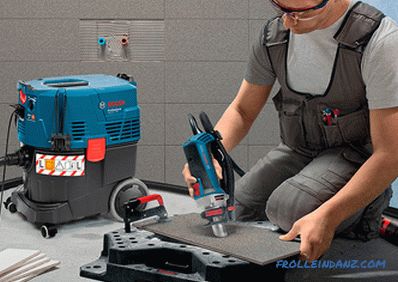
# 2. Connect directly to the instrument. Many modern power tools are equipped with a dust removal system - a special nozzle for dust emission to which you can connect a vacuum cleaner hose. The amount of dust in the air and on the workpiece itself will be minimized.The connected hose somewhat interferes with the control of hand-held power tools, but for the sake of comfortable working conditions, it is quite possible to put up with this little inconvenience.
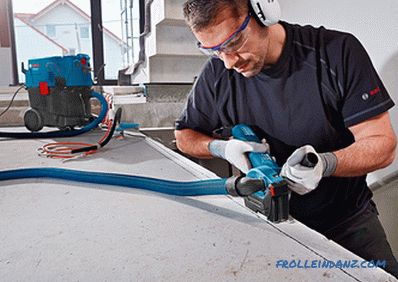
# 3. Room cleaning at the end of work. Trash and dirt that has accumulated in the workplace can be removed after work is completed using a vacuum cleaner in the most traditional way.
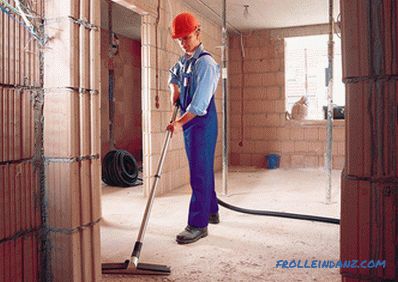
Dust collectors and filters
As well as household vacuum cleaners, construction are divided by type of dust collector into bag and bagless. The first version can be equipped at the request of the user and in accordance with the recommendations of the manufacturer as reusable (textile) and disposable (paper) bags. The group of bagless vacuum cleaners is also heterogeneous, in it can be distinguished two structurally distinct subgroups - cyclone (container) and water vacuum cleaners. Consider the features, advantages and disadvantages of all four types of dust collectors for construction vacuum cleaners.
Fabric bags
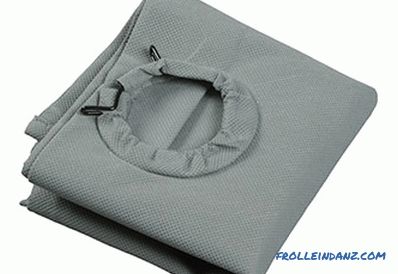
Reusable fabric bags are best known to users because they continue to be the most common in conventional home vacuum cleaners. After filling such a bag with debris and dust, it should be emptied, shaken out and reinstalled. The number of cycles of use of such a dust collector is quite large, and therefore this option can be attributed to a low budget. For the manufacture of reusable bags for vacuum cleaners used previously satin - a cheap and at the same time quite durable and durable material. Today, satin is practically not used for these purposes, it is superseded by synthetic fabrics. Recently, flizelin has become increasingly popular as a material for the manufacture of reusable dust collectors.
We have already mentioned the main advantage of reusable fabric bags - this is low cost per one filling cycle. But they also have a significant drawback, which the future owner of a construction vacuum cleaner should definitely be aware of. The fabric, well retaining relatively large particles, easily passes fine-grained construction dust, which with a stream of air coming out of a vacuum cleaner scatters over long distances, evenly covering all surfaces. However, modern double-layer fabric based on non-woven fabric is capable of catching even small particles several microns in size, thereby ensuring a good degree of cleaning.
Paper bags
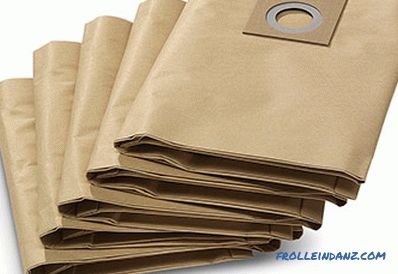
Disposable paper bags in the direct sense of this layer are consumables: being filled, they, along with all the contents are sent to landfill. For the user, this means, on the one hand, ease of use, but on the other hand, additional expenses, and not so little. The cost of one paper bag for a construction vacuum cleaner is $ 5-6, and once you realize that you have already spent on consumables more than on the equipment itself. In addition, disposable bags, like all consumables, tend to run out, and at the most inopportune moment, and it may turn out that you will be forced to quit work and begin to run around the shops in search of bags for your model of vacuum cleaner.
However, the whole barrel of honey falls on this fly in the ointment. Paper dust collectors possess excellent operational characteristics. They significantly exceed their tissue counterparts in their ability to trap fine particles (up to 0. 3 microns in size), which means that the indoor air will be clean, and you will have to clean less often and replace additional filters.
But with large debris you need to be careful: some large particles (broken glass, sharp pebbles, metal chips) can easily tear the paper walls of the dust collector.
Container dust collector
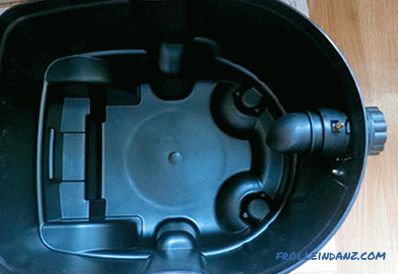
In cyclone-type vacuum cleaners, all garbage is collected under the action centrifugal force in built-in tank. The disadvantages of the aggregates of this type include the increased noise of the work, which is a result of repeated collisions of solid particles trapped in the tank, with its walls, and the limited use. The latter is expressed in the fact that "cyclones" are suitable only for collecting large particles, water and wet debris. Many cyclone models support bagging. When using a bag, the main filter is much less clogged.
Aqua-filter
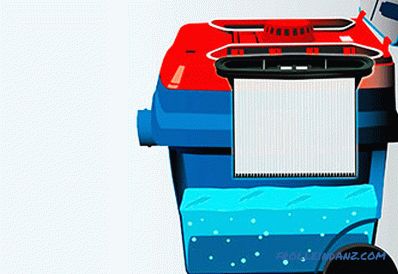
In vacuum cleaners with an aqua-filter, intake air is passed through water, where large-fractional debris settles. Smaller particles are trapped in the compartment next to the water tank - the separator. Such a multi-stage cleaning system gives the best result. The reason why many prefer vacuum cleaners with other types of dust collectors rather than this seemingly ideal variant is the high cost of water filter units.Another disadvantage is the inability to cope with large volumes of construction waste. In addition, it should be mentioned that the only consumable for such vacuum cleaners is water. This feature of them could be attributed to the benefits, but do not forget that in the conditions of the premises where repairs are underway, large volumes of clean water are often simply not available.
In addition to the dust collector, the filtering system of the vacuum cleaner includes one or several fine air filters. Such filters, which are disposable and reusable, are made of nylon (for fine dust), polyurethane (for intake fluid) or a number of other, usually synthetic materials. Their main function is to trap a fine suspension of construction dust that did not stay in the main tank / bag. It is on these filters that the quality of the cleaning of the room and the degree of engine wear depend. As well as the main dust collector, they need periodic cleaning of accumulated dirt. A dust-clogged filter is the main cause of a decrease in the performance of a vacuum cleaner and an increase in the load on an electric motor. If you decide to save on the vacuum cleaner itself and the quality of the main dust collector, be prepared for the fact that you will have to clean and replace the filters more often.
Types of construction vacuum cleaners and their purpose
Professional and household
Vacuum cleaner related terms “construction” and “industrial”, equally used in this article, are not really synonymous. All vacuum cleaners used in production and in the implementation of repair and construction works are divided into professional and household (the latter should not be confused with those that you use to clean the carpet at home).
They differ in dust collector volumes, capacity (i.e., intake air volume per unit of time), suction force, engine life and allowable non-stop operation time. To make a choice between a professional and household vacuum cleaner, you just need to assess the intensity with which you plan to use this technique. If we are talking only about a few weekly work hours somewhere in a small home workshop or about carrying out repairs in the apartment on our own, then you will have a fairly inexpensive household option. If the vacuum cleaner is planned to be used in a large-scale production, where he will have to work on a par with people, that is, the entire work shift, then there is no professional model.
Distinction of construction vacuum cleaners by purpose
Construction vacuum cleaners are classified and according to their purpose, i.e. the type of contamination that they have to clean. The following types can be distinguished here:
# 1. For dry cleaning. This is the simplest option, in fact, all vacuum cleaners cope with this function. Such aggregates differ from ordinary household “brothers” only in terms of power, performance and quality of filtration. Used for collecting cement, gypsum, lime dust, etc.
# 2. For dry and wet cleaning. Such devices can handle not only dry waste, but also liquid spilled on the floor.
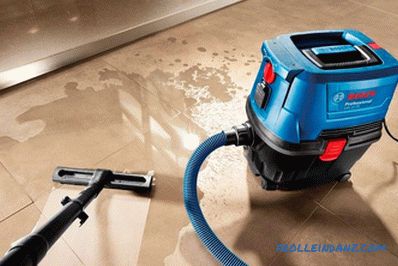
# 3. Washing vacuum cleaners are capable of collecting dry dust, but their main purpose is still the wet cleaning of industrial premises, places where people have a high level of traffic, etc.
# 4. For cleaning explosive and fire hazardous waste. Such vacuum cleaners are designed to collect aluminum or zinc powder, coal dust, industrial waste of organic origin (sugar, flour, wood dust, etc.). These models are completed with electric motors without graphite brushes, which are the cause of sparking. In addition, for such units, a mandatory requirement is the presence of the function of measuring the speed of air flow. Vacuum cleaners in explosive execution, perhaps the most expensive, but they are used only in enterprises with narrow focus.
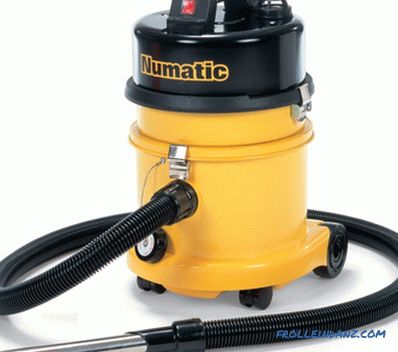
# 5. Heat-resistant vacuum cleaners are also highly specialized. These can only be met at a limited number of enterprises. As the name implies, such units are used to collect hot industrial waste (for example, heated metal chips during processing).
Criteria for choosing a construction vacuum cleaner
A construction vacuum cleaner is a fairly expensive tool, so it’s important not to be mistaken with its choice. Focus exclusively on a reasonable price and the familiar name of the manufacturer is not worth it. In order for the new unit to satisfy all your requirements and at the same time its acquisition did not turn out to be a financial collapse for you, you should think over all the nuances in advance. Let's talk about the main parameters that need attention.
Conditions of the upcoming operation
In order to understand which construction vacuum cleaner to choose, do you need a professional unit, or can you more easily cope with your tasks with a simpler household appliance, do you need a narrow specialization tool, and if so then which one, try to answer a number of questions for yourself. How often is a vacuum cleaner supposed to be used? Will it be operated in a small home workshop or in large-scale production? Is it necessary to collect garbage in a dry room or on a regularly flooded area? Will it be enough just to collect dust or do you need to scrub floors to shine?
Do not forget that dust is different, and this aspect must also be taken into account. If the vacuum cleaner is designed to collect explosives, corrosive liquids or red hot metal shavings, you will have to look for a specialized model. It should be mentioned here that all pollution is divided according to the degree of its danger into several classes (and all manufacturers of vacuum cleaners must indicate what their equipment is designed for):

| L - low degree of danger (most construction waste), when collecting these contaminants it will be enough to use a simple nylon filter, the emission into the atmosphere should not exceed 1%; |

| M - the average degree of danger (wood and concrete dust, waste from the processing of copper, nickel, manganese), is required to use several filters capable of catching up to 99. 9% of all waste; |

| H - high degree of danger (lead, asbestos and other carcinogens, wastes with a high concentration of microorganisms (mold, fungus, viruses, bacteria), toxic chemical compounds, dust from nuclear power plants), require a complex filtration system and function to measure air velocity, it is necessary to ensure collection of 99. 995% of waste and their dust-free disposal; |

| ATEX - explosive and flammable waste (aluminum Separated, carbonic sugar, flour dust and so on. d.) requires the use of explosion-proof equipment (not lower safety class IP 54). |
Power and performance
These two parameters are directly related to each other: the greater the power of the electric motor, the higher the performance of the vacuum cleaner and, as a result, its life . The power consumption of construction vacuum cleaners is 1. 0-1. 4 kW, which allows them to pass through up to 50 liters of air per second. In professional models, the power is even higher (up to 7 kW), and this provides a performance of 60-100 l / s. There are vacuum cleaners (for example, Makita-449) with two motors connected in parallel: depending on the situation, you can turn on one (and save electricity), or both (and increase productivity). The greater the power, the greater the safety margin of a construction vacuum cleaner, and this is important.
Degree of vacuum
The vacuum generated by the vacuum cleaner's fan determines the strength of its suction. In construction vacuum cleaners, the value of this parameter ranges from 17 to 250 millibar. The better the vacuum, the heavier particles a vacuum cleaner can suck. The degree of rarefaction allows you to better assess the efficiency of the vacuum cleaner than the power consumption.
The volume of the dust collector
The volume of the dust collector of construction vacuum cleaners, as a rule, is 20-50 liters. If the volumes of garbage to be cleaned are small, you should not chase after a large volume of the dust collector, because the growth of this parameter will lead to an increase in the size and weight of the unit. But for professional models designed to work in large-scale production, the volume of the dust collector can reach 100 liters (this allows not to take frequent breaks during the work shift to empty it).
Vacuum cleaner case
The construction vacuum cleaner case is made of impact-resistant materials - metal (aluminum, brass, stainless steel) or reinforced plastic. Often, a bumper is installed around the perimeter, which serves to prevent the body from accidentally striking a wall or other obstacle. Taking into account the large weight of construction vacuum cleaners (add here the weight of the collected garbage) when choosing, it is necessary to pay close attention to the functionality and reliability of the wheels, as well as handles for transportation. Of great importance, and you are convinced of this in the process of operation, have the length of the power cord and the length of the hose.
Additional options
Some models of vacuum cleaners have additional functions that are not necessary, but facilitate the operation of equipment (of course, the more functional the tool, the more expensive it is).
Consider the most important:
# 1. Power socket. Power socket on the case of a vacuum cleaner for direct connection of power tools. By plugging the instrument into such an outlet, the vacuum cleaner will turn on only when you have activated the instrument (press the button on the instrument). After turning off the tool, the vacuum cleaner will turn itself off with a slight delay. This is a very convenient option, but when choosing a vacuum cleaner, look at the maximum possible power of the tool that you plan to connect to this outlet. Look at the power of the power tools that you are going to use in conjunction with a vacuum cleaner and focus, when choosing a vacuum cleaner, on the tool with the most power.
# 2. Suction force regulator. This function is not available in all models, but in some cases of using a vacuum cleaner its presence is very convenient. With this function, you can change the draft, depending on the intensity of dust formation and the type of moor.
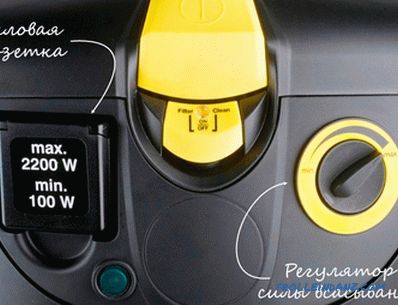
# 3. Automatic filter cleaning function. When using the vacuum cleaner, the main filter element becomes clogged and needs to be cleaned. In order not to disassemble the vacuum cleaner each time, to clean the filter, some models are equipped with an automatic cleaning function. This system is installed above the filter and has a special valve that changes the direction of the air flow and blows the filter clearing from clogs. The system can operate in automatic mode and operate at the moment when the passage of the air flow has become difficult, and forcibly in manual mode. Such vacuum cleaners are much more expensive, but if you intend to use the vacuum cleaner quite intensively, the system is worth it.
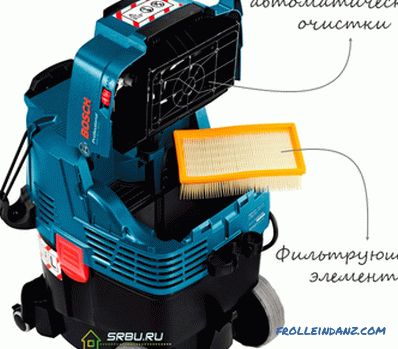
# 4. Adapters for connecting the vacuum cleaner hose to the dust removal system of tools, as well as hose splitters, which allow you to simultaneously connect two or more dust-generating devices.
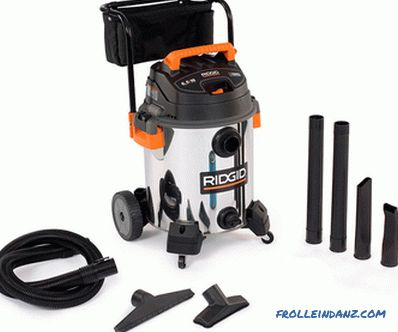
# 5. Light indication of the condition of the vacuum cleaner informing the user of a clogged hose or filter, overflow of the dust collector, etc.
# 6. Motor overload protection (this function is especially important for industrial vacuum cleaners that are used in harsh conditions of large-scale production).
What you need to know about serviceability
Like any other technology, construction vacuum cleaners require attention and care. Only under this condition, they will serve you for a long time and efficiently perform all their functions. Vacuum cleaner maintenance is reduced to regular cleaning / replacing the dust box and filters.
Easy maintenance of various dust collectors
Which dust collector is easier and faster to clean? Of course, a paper bag: being disposable, it is simply disposed of along with the contents, and a new one is put in its place. All other dust collectors — a reusable cloth bag, a container of a cyclone-type vacuum cleaner or a tank of water from an aqua-vacuum cleaner — require emptying and subsequent cleaning. Spending money on consumables or wasting time on cleaning reusable components depends on the mode of operation of the vacuum cleaner and on your desire / ability.
Regular cleaning of filters
Air cleaning filters also require periodic cleaning. The owner of an unpretentious vacuum cleaner will have to do it yourself: a filter clogged with dust must be removed, cleaned with a special device, rinsed with running water and dried. Owners of more advanced models with the function of pneumatic impact, there is no need to do all these manipulations - just press the button, and a powerful stream of air moving in the opposite direction, will dislodge all the dust from the filter. Finally, premium models themselves perform a similar action at regular intervals, so you don’t even have to think that filters need cleaning. The only question is whether you are ready to pay for it ...
Now you know how to choose an industrial vacuum cleaner. With the information received, you can easily navigate in the range and be able to make the right choice.
Video: How to choose a construction vacuum
